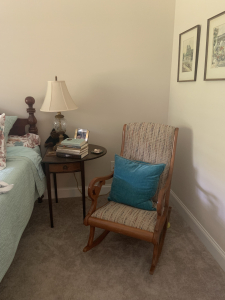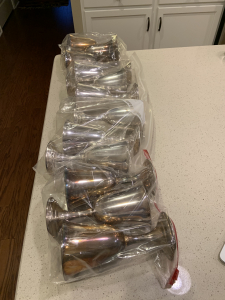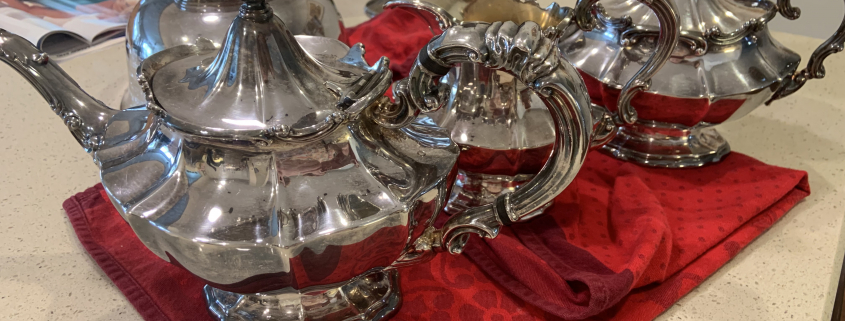Antiques road show, family-style
For those targeted in the demographic as “mature” readers, there is a wealth of material everywhere you look these days replete with advice about disposing of your belongings, especially older items.
Perusing this advice is not recommended on a dark and dreary day. Do the closet purging now, so your children don’t have to later, admonishes one so-called expert. Get rid of everything that doesn’t bring you joy, preaches another. (That one especially inspires a gag reflex. Seriously? My vacuum cleaner doesn’t bring me joy, but some things are just necessary. And I’m not turning my house into a personal temple to my own rapture. Spare me.)
And then there are the dire predictions about locating useful destinations for your objects, especially items from bygone days. The problem is not what to purge, reads one article, but what to do with what you are shedding. No one wants your stuff, one writer declares—especially not your children—and particularly old dishes, glassware, and silver. Even charities serving the needy may not accept such items, and readers are advised to research this carefully. What to do? Facebook marketplace? eBay, where listings appear to linger for ages?
I suppose it is likely that some of our long-used family belongings could someday end up in such places.
But you’d have to catch them first. That’s because many of our family pieces have logged more miles than the newly retired with the keys to a sparkling new RV. As a tribe, we give our own special meaning to the phrase “antiques road show.”
Let’s begin with an old maple rocking chair, with elegantly curved arms, a wonderfully tilted back, and the long, deep rockers that make for a fine, fine rocking interlude. That chair has at least 400 miles on it. When wewere dispersing items after my father’s death, the rocker traveled home with me from Kentucky to Tennessee, and after I moved again a few years later to more limited space, it traveled back up the exact same road to a sunlit spot in my sister’s larger house.
These travels are not limited to comfortable furniture. I recently came into possession of a dozen gleaming silver-plated water goblets, future use as yet undetermined, but gosh, they are eye-poppers. If I think carefully about history and lineage (a dangerous thing in such situations), I believe mine is the fifth family home in in which they have resided. It’s

best not to attempt a road mileage total on that one.
My longtime interior design consultant and dear friend once described my home design style as “inherited.” And while that one got a roar of appreciation when I shared it in the fam, the pattern emerged decades ago for very practical reasons. It’s not that my house is crammed with items representing some overburdening emotional obligations. It began as much the opposite: Any furniture from family sources I liked and could use, as a young person starting out, was a piece I didn’t have to pay for.
Still, I freely admit our family treasures may offer some endearing, tangible connections to those who passed them on. A few years back I was mesmerized by a fascinating book about Te Māori, the first U. S. exhibition of ancient art from the native Māori people of New Zealand. The opening of the exhibit at the Metropolitan Museum in New York was preceded by elaborate tribal rituals symbolizing honor for and protection of the ancestral artists, who are believed by the Māori to spiritually inhabit the art they created.
 My own treasured artifacts mostly weren’t made by our earlier generations, but I still enjoy thinking about what their spirits, if residing therein, could pass on to us. Could I replicate the hospitality at my own dinner parties that always illuminated my parents’ home by remembering to pull out my mother’s crystal wine glasses? If we keep that old rocker in the family circle, will we someday emulate with our younger members the long conversations I had with my dad when I sat in it, across from his favorite perch in their den, while we chatted?
My own treasured artifacts mostly weren’t made by our earlier generations, but I still enjoy thinking about what their spirits, if residing therein, could pass on to us. Could I replicate the hospitality at my own dinner parties that always illuminated my parents’ home by remembering to pull out my mother’s crystal wine glasses? If we keep that old rocker in the family circle, will we someday emulate with our younger members the long conversations I had with my dad when I sat in it, across from his favorite perch in their den, while we chatted?
In our defense, we are at least beginning to think and talk about “re-homing” some of these family items, as the term is currently used in reference to rescue animals, not necessarily a flawed analogy. As the current trustee of two sets of fine china from two generations back, I was recently struck by the notion that two might be one too many.
I really need to make some more space in my cabinets, I lamented on the phone to my sister, and I don’t really want to start packing things away in storage boxes. “I know, I’m the same,” she answered with a sigh. “We aren’t moving anywhere, anytime soon, but I am starting to think about what I can begin to purge from this house, working toward when that time comes.”
There is a particular, unspoken code for these family chess moves, and I was careful to follow it: I’m probably going to get rid of Mamama’s good china, I continued. (Mamama being our maternal grandmother.) I just don’t use it or need it. That is, of course, unless you want it.
Pause for here for a millisecond of dead air in the ether. “Wait,” she pondered. “Which ones are those?” Absorbing my description of the old ivory porcelain with the brightly flowered centers, she suddenly leapt the tracks on the strategic execution for starting-to-get-rid-of-stuff. “Actually, I might take those.” She had reasons, of course, but they elude memory at the moment, because she had a chess move of her own lurking. “You might want these ones I have that were Snowy’s (our paternal grandmother). They’re all-white, and they’re gorgeous. You’d really like them. As a special bonus offer, I’ll throw in the cushioned, zippered containers I bought to keep them in and protect them from chipping.”
The absurdity of this exchange finally ignited a roar of laughter from both guilty parties, but even that burst of self-knowledge does not appear to be forestalling next steps. More road show might be coming. “I’ll send you a photo,” she said, “and if you want them, I’ll bring them when I come down to visit in a couple of weeks. And I’ll take the others, if they are the ones I am remembering.”
On it goes. On a recent weekend afternoon, a text from my daughter inquired what I was doing. I confessed to furiously polishing an ornate, silver-plated, Victorian-style tea and coffee set that belonged to a great aunt who died 40 years ago. Even the hopeless optimist in me knows that charities have no use for such things these days, and a perusal of eBay showed too little value to be worth the trouble of the transaction.
What am I going to do with this thing? I asked her, rhetorically. “Maybe use the sugar bowl to store device cords,” she attempted, helpfully. “And water your plants with the teapot?”
That’s my girl, I thought, a bright flicker of pride warming my heart and emboldening me to push forward another step. I sent a photo of the silver water goblets, asking, “I don’t suppose you want any of these? No obligation, no hurt feelings if you don’t.”
And it was the second half of her response that turned the flicker in my heart into a warm, enduring beam of hope for the next generation. “Sure, I’ll take some. Now, whose were those, again?”



